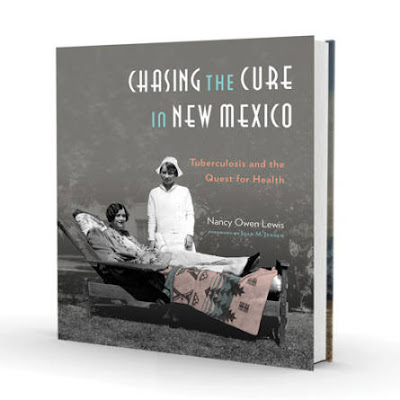The Cure
In the early years of the 1900s, before New Mexico was a state, the small, sparsely settled town of Santa Fe attracted people from the US states for a specific reason. They came to be cured. Tuberculosis was a terrible disease and before antibiotics it was thought dry mountain air could cure it.
 |
| Nancy Owen Lewis: Chasing the Cure in New Mexico Tuberculosis and the Quest for Health |
One theory at the time was that the bacterium could not survive above 5,000 feet. There was no medical evidence for that at all, but people came to this high elevation outpost believing it.
Patients came initially to a tent city that sprang up near town, with the promise that tent living, hiking, and an active outdoor life would "toughen them up." It was called the heroic cure. Later, sanatoriums were built with hospital staff and amenities like sunrooms and art studios. It became an early kind of health-tourism industry.
 |
| Sunmount Sanitorium in Santa Fe, about 1920 |
Another theory for a time was that tuberculosis was hereditary, not communicable. Promoters hoping to attract patients to New Mexico's sanitoriums said the climate was so beneficial that the native populations never got sick and were obviously immune. That was a devastating falsehood and local populations suffered tragically when infected people began arriving.
New Mexico was not admitted as a state until 1912, and one of the things holding it back for so many long frustrating years was that it was too "foreign" to join the US. Too Catholic, too many indigenous people, too Spanish speaking, some doubt about these foreigners' loyalty to America. But there was a source of loyal, mainstream Anglos who would gladly come to the territory: the lungers. The sick.
So the business community and officials of the territory set out to deliberately attract an Anglo population -- an unhealthy one but no matter, it would make this strange southwestern land seem more palatably American. By the 1920's 10% of New Mexico's non-native population were health seekers.
Health tourism was the fourth largest industry in the territory / later the state, after ranching, railroads and mining.
 |
| St. Vincent's Catholic-run TB sanitorium in Santa Fe. |
Traveling to Santa Fe a hundred years ago and staying for an extended time in a private sanitorium was not cheap. Before statehood there was no public funding for health. So those seeking a cure were from money. Santa Fe specifically set out to attract the wealthy sick and well educated invalids.
These patients of means and education kept themselves amused during long convalescences with arts and culture, and many who survived the illness stayed on in this city and grew it into the arts mecca it eventually became.
In 1949 tuberculosis became treatable with antibiotics. The sanitorium buildings eventually were repurposed into a hospital, a hotel, a Catholic Sisters of Charity retreat. But the legacy of well to do Anglo tourists recruited to Santa Fe to re-make the culture and Americanize the city and state is one we still contend with.
I'm part of that -- I'm an east coast Anglo of means who came for my retirement, not for my health, but it's interesting to know I continue a long effort to define what being American is in this strange seeming outpost of the country.
And yes, I do breathe better here.

Comments